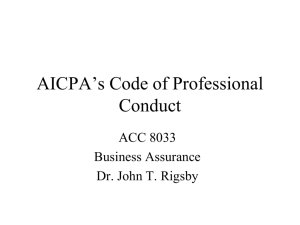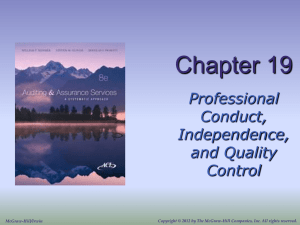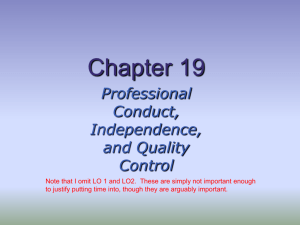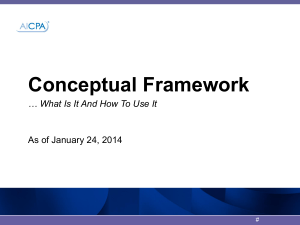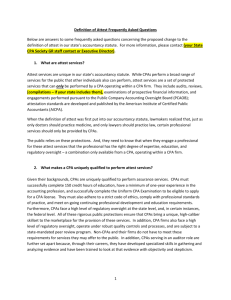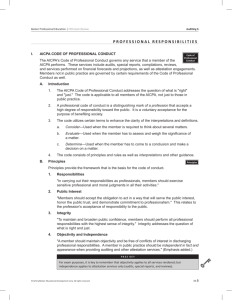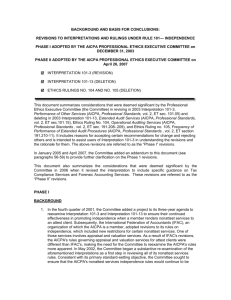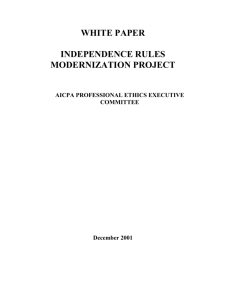AICPA`s Code of Professional Conduct
advertisement
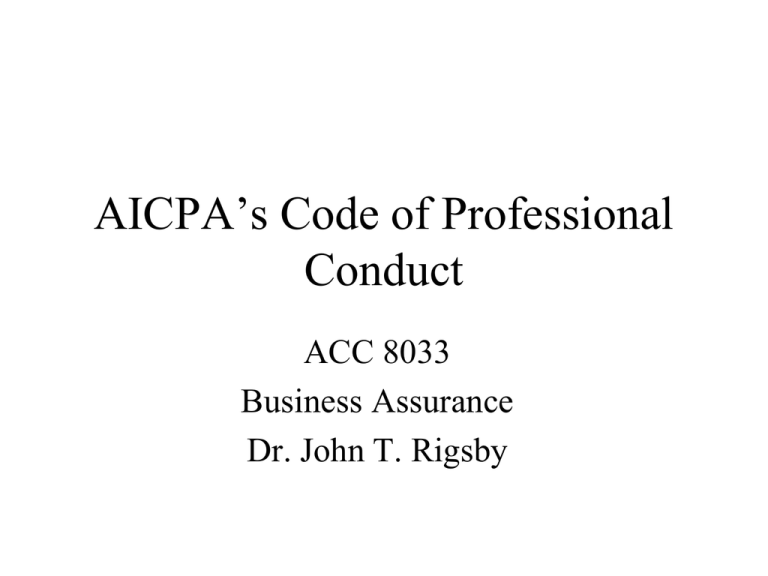
AICPA’s Code of Professional Conduct ACC 8033 Business Assurance Dr. John T. Rigsby Accessing AICPA’s Code of Professional Conduct • To access the Code of Professional Conduct, go to the AICPA’s website and hit Interest Area, then Professional Ethics. You then can read the actual requirements of the Code of Professional Conduct. • The reformated Code has been broken up into three Parts depending upon the area of practice: public practice, members in business, and other. Classifications 1. Principles–provide broad framework for professional conduct \ are not enforceable 2. Rules-were passed by membership as guidelines for behavior and are enforceable 3. Interpretations-issued by Executive Committee of AICPA’s Ethics Division to provide guidance in applying Rules and are enforceable 4. Ethical Rulings-also issued by Executive Committee to provide guidance in specific factual situations Principles 1. 2. 3. 4. 5. 6. Exercise Moral Judgments Act to Serve the Public Interest Act with Integrity Maintain Objectivity and Independence Exercise Due Care Satisfy these principles in determining the nature and scope of services offered Applicability • Applies to all professional services, except where wording indicates otherwise. • Members are held responsible for persons associated with them in public practice. • You cannot use others to do things that you cannot do yourself. Independence Rules Applies to ‘Covered Members’ • You are a covered member if you are: – An individual on the attest engagement team; – An individual in a position to influence the attest engagement; – A partner or manager who provides more than 10 hours connected to attest engagement; – A partner in the lead office in which the lead engagement partner primarily practices; – The firm (entity) providing the attest services; – Any entity controlled by those mentioned above Impairs Independence even if not a Covered Member • The following rules apply to all partners and professional employees of a firm: – No partner or professional employee of the firm may be employed by an attest client and serve as a director, officer, promoter, underwriter, voting trustee, or trustee of pension plan – No partner or professional employee may own more than 5% of an attest client’s outstanding equity securities (includes immediate family) Rule 101-1 Independence • A member in public practice shall be independent in the performance of professional services as required by standards promulgated by bodies designated by Council. Rule 101-1 Independence A. During the Period of the Engagement 1) Prohibits direct or material indirect interest in client. 2) Can’t act as trustee, executor, or administrator of estate if have such direct or material indirect financial interest. 3)Prohibits joint, closely held investments with clients or its officers and directors. 4)Prohibits loans to or from the client, with certain exceptions Rule 101-1 Independence B. During the period of the engagement a partner or professional employee of the firm or their immediate family or any group of such persons acting together cannot own more than five percent of a client’s outstanding equity securities or ownership interests. Rule 101-1 Independence Relationships with Client C. During the Period of the Financial Statements or of the Engagement 1) Prohibits being director, officer, or employee of client, or acting in any manner equivalent to management. 2) Prohibits being a promoter, underwriter, or voting trustee of a client. 3) Prohibits acting as a trustee for any pension or profit-sharing trust of the client. Employment Relationships of Covered Members • A former officer, director, promoter, ect. would impair the independence of the CPA firm if they participated on the attest engagement or were in a position to influence the attest engagement for the period that includes their employment with the client • Subsequently is ok, but must dissassociate from client, e.g., pension plans, loans, etc. Covered Member Immediate Family Independence Rules • Immediate family members are considered the same as the covered member, with the following exceptions: 1) Employed in a non-key position of a client. 2) Participation is ok in retirement, savings or similar plans that are offered to all employees and family member does not serve in a position of governance for the plan or supervise/participate in plan’s investment decisions. Covered Members Close Relative Independence Rules • Normally independence rules do not apply to close relatives, with the following exceptions: 1) Has a key position with the client. 2) Has a material financial interest in the client known to the covered member. 3) Able to exercise significant influence over the client. • Reasonable person rule: refer to risk-based approach of Conceptual Framework Rule 101-2 Independence Former Practitioners • If former partner or professional employee goes to work for client in a key position, it would affect independence if all of the following conditions are not met: • (1) Amounts due former practitioner are not material and remain fixed by formula • (2) Former practitioner not in a position to influence CPA firm’s operations & policies Rule 101-2 Independence Former Practitioners (cont’l) • (3) Former practitioner does not participate nor appear to be associated with CPA firm • (4) The attest engagement team modifies appropriately the audit engagement plan • (5) The CPA firm evaluates stature and experience of engagement team members • (6) The attest engagement work is reviewed that professional skepticism was maintained Rule 101-2 Independence Current Team Members • The CPA firm’s independence would be impaired if an attest team member was offered a job by the client unless: – It is promptly reported to firm; – The individual removes themselves from the engagement until the offer is rejected or employment is no longer sought • Covered members should report such concerns to their superiors • Prior work may need to be re-evaluated Rule 101-3 Independence • Accounting Services Normally can provide accounting services to client and audit them as well. However, 1) Member cannot assume the role of employee or of management. Can provide advise and recommendations. 2) The client must accept responsibility for the financial statements. Normally assign competent employee to oversee the activity. 3) Member must document in writing circumstances of services rendered with Bd of Directors Rule 101-3 Independence (cont’l) • Note that for SEC clients members cannot perform accounting services and also do an audit. • In that situation, the SEC would consider the member firm to lack independence. • Difference is size of client. Clients requiring write-up work tend to be small with limited accounting personnel. Rule 101-4 Independence • Honorary Directorships Normally ok so long as clearly designated as honorary and the member does not participate in decision-making. Rule 101-5 Loans from Financial Institutions • Normally considered to impair independence except for certain situations: (1) grandfathered loans as of February 5, 2001, and (2) other permitted loans specifically listed, i.e., a) collateralized auto loans, b) loans of the cash surrender value of an insurance policy, c) borrowings fully collateralized by cash deposits at same institution, d) and cash or credit card advances of less than $10,000. Rule 101-6 Litigation • Actual or threatened litigation between the client and member over deficiencies in audit work or management fraud or deceit normally would impair independence. • However, litigation of an immaterial amount and for reasons unrelated to the audit (e.g. billings for services) normally would not impair independence. Rule 101-6 Litigation (cont’t) • Normally, litigation by parties other than then client, e.g., by stockholders, creditors, etc., will not impair independence so long as it does not impinge upon the auditor/client relationship. • Always consider whether a reasonable person having knowledge of all the facts would conclude that actual or intended litigation poses a threat to the auditor’s independence. Rule 101-8 Independence • Investor/Investee Relationships 1) When the client has a material investment in a non-client firm, any direct or material indirect investment by the auditor in the non-client firm would impair their independence. 2) If the client’s investment was immaterial to them though, only a material investment in the nonclient firm would impair the auditor’s independence. Rule 101-8 Independence (cont’l) • 3) When a non-client firm has a material investment in the client, then any direct or material indirect investment by the member in the nonclient firm would impair their independence. • 4) If the non-client firm’s investment was immaterial though, then investment by member in non-client firm would only affect independence if investment allows them to exercise significant influence over the non-client firm. • Rules are not very exact. Again apply the reasonable person rule to the specific situation. Rule 102 Integrity & Independence • Independence is not always required; mainly when one is performing attest services, e.g., audits or reviews • The practitioner, though, is always required to act with integrity and objectivity. • This means not to knowingly misrepresent facts or to subordinate your judgments to others. Rule 201 General Standards • Makes these four standards applicable to all types of services rendered by the practitioner: 1) Professional Competency 2) Due Professional Care 3) Planning and Supervision 4) Sufficient, Relevant Data Rule 201 General Standards (cont’l) • Competency- You can accept a job that you are not presently competent to perform if you expect to receive training shortly so that you can perform the job. • If, however, you cannot complete the training to perform the job, then you must refer the engagement to someone else. Rule 202 Compliance With Standards • Members are required to comply with standards of bodies designated by Council • For example, PCAOB, SEC, ect. Rule 203 Accounting Principles • Members must comply with GAAP. • In some rare circumstances, however, if because of unusual circumstances to do so would result in misleading financial statements members may give a clean opinion, but must disclose the departure and its approximate effect in the audit report. Rule 301 Confidential Client Information • Members cannot disclose confidential client information without consent of the client. • There are four exceptions: 1) To comply with Rule 202/203. 2) To comply with subpoenas, laws, and government regulations. 3) To comply with professional requirements, e.g., AICPA, state CPA societies, or state Board of Accountancy Rule 301 Confidential Client Information (cont’l) 4) May initiate a complaint or respond to an inquiry made by ethics or trial board of professional bodies, e.g., state Board of Accountancy or state CPA societies. Rule 301 Confidential Client Information (cont’l) • Members who become privy of confidential information in ethics reviews, peer reviews, or trial boards of state CPS societies or state Board of Accountancy have the same responsibilities not to disclose that information. Rule 302 Contingent Fees • A contingent fee is where receiving a fee and/or the amount of the fee is dependent upon something happening or not happening at some point in the future, e.g., winning a lawsuit. • * PCAOB does not allow contingent fees for auditors of publicly traded companies. • Under AICPA’s rules, members can accept contingent fees except for some services. Rule 302 Contingent Fees (cont’l) • Member would lack independence if a contingent fee is associated with a client for which the member performed: 1) an audit or review of financial statements, 2) a compilation, or 3) an examination of prospective financial statements for a client. • Or if prepared an original or amended tax return for a contingent fee Rule 302 Contingent Fees (cont’l) • Note that this rule is not accepted by all state Boards of Accountancy, e.g., Mississippi. In Mississippi contingent fees are completely outlawed for all services. • Where it is accepted, there must be disclosure of the facts of the circumstances to the client so that they can make their own judgment as to its possible effects. Rule 400 Responsibilities to Colleagues • Presently there are no rules regarding responsibilities to colleagues. Rule 501 Acts Discreditable • This is a catch-all. Whenever the member does something that is not covered elsewhere, then this one applies. • Examples are retention of client’s working papers to enforce payment of fees, nonpayment of income taxes, or filing fraudulent income taxes. Rule 502 Advertising • All types of advertising are allowed by members so long as the advertising is not false, misleading, or deceptive. Rule 503 Commissions and Referral Fees • An example of a commission is where the practitioner is paid a certain amount of money if sales of a product or service is made to a client of the practitioner. • An example of a referral fee is where the practitioner receives (or pays) a certain amount of money for referring companies or products to a client. Rule 503 Commissions and Referral Fees (cont’l) • Under the AICPA’s rules, members can accept commissions or referral fees except under some circumstances. • These three circumstances are the same as for contingent fees. 1) performing audit or reviews for clients, 2) performing compilations for them, or 3) examinations of prospective f/statements. *Must disclose to parties receiving recommen Rule 505 Form of Practice and Name • Members may practice in any form of organization permitted by state law, e.g., partnership, professional organization, and limited liability corporation, that conforms to resolutions of Council. • The name of the CPA firm may be fictitious or indicate specialization, so long as it is not false, misleading, or deceptive. • Firms may designate themselves “Members of the AICPA” only if all partners/shareholders are members of the AICPA. AICPA Conceptual Framework for Independence • Risk-based approach to analyzing independence matters. • Requires independence for all attest engagements of both ‘independence of mind’ and ‘independence in appearance’. • Requires a determination if influences create an unacceptable risk that a member would not act with integrity and objectivity in the conduct of a particular engagement, or would be perceived as not being able to do so by a reasonably and informed third party that has knowledge of all relevant information. • Conceptual framework has been broaden from audit independence in recent years to include all types of ethical situations. There now are two conceptual frameworks, one for members in public practice and one for members in business. The AICPA’s Code of Professional Conduct is applied within these conceptual frameworks. AICPA Conceptual Framework • Three step process: – 1. Identify and evaluate threats to independence. If no threat or if threat is not significant can proceed. A threat is at an acceptable level when a reasonable and informed third party who is aware of relevant information would conclude that the threat would not compromise compliance with the rules. – 2. Identify safeguards (existing or new ones). While one safeguard may eliminate or reduce multiple threats, in some cases you may need to apply multiple safeguards to eliminate or reduce one threat to an acceptable level. Safeguards may deal with procedures within the CPA firm and the client as well as within the profession and the society. – 3. Determine whether safeguards eliminate or sufficiently mitigate identified threats. If can’t sufficiently eliminate threats or reduce them to an acceptable level, independence would be considered impaired. AICPA Conceptual Framework for Independence • Seven broad categories of threats to independence: – – – – – – – 1.Self-review threat—can’t audit your own work 2. Advocacy threat---actions promoting client’s interests. 3. Adverse interest threat---e.g., commencing litigation by client against auditor. 4. Familiarity threat---too close or longstanding relationship with attest client. 5. Undue influence threat---attempts to coerce member by management or others. 6. Financial self-interest threat---potential of financial benefit to member. 7. Management participation threat---taking on the role of management. • Three broad categories of safeguards. Safeguards are controls that eliminate or reduce threats to independence. - 1. Those created by the profession, legislation or regulation. - 2. Those implemented by the attest client. - 3. Those implemented by the firm, including policies and procedures. AICPA Conceptual Framework • Illustration: A audit senior with a CPA firm has a close relative who works as a vice president for an important audit client. Does it affect the independence of the audit firm with respect to that client? How can it be dealt with to eliminate or mitigate the potential threat to independence? • 1. Covered members would lack independence if they had a close relative with a key position with an audit client. • 2. Safeguard would be to assign other seniors to work with this audit client. If this senior worked was a covered member for this client on this audit it would impair the independence of the CPA firm and invalidate the audit. • 3. Independence of the CPA firm with respect to this client is preserved and the threat is adequately mitigated by having other audit personnel work for this audit client.
